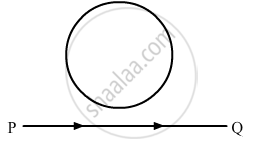Advertisements
Advertisements
प्रश्न
A rod of length l is moved horizontally with a uniform velocity 'v' in a direction perpendicular to its length through a region in which a uniform magnetic field is acting vertically downward. Derive the expression for the emf induced across the ends of the rod.
उत्तर

Consider a rod PQ of length l moving in a magnetic field `vecB`with a constant velocity `vecv`. The length of the rod is perpendicular to the magnetic field and the velocity is perpendicular to both field and the rod. The free electrons of the rod also move at this velocity v⃗ due to which it experiences a magnetic force
`vec(F_b)=qvecvxxvecB`
Here, q = 1.6×10-19 C is the charge of a electron. This force is towards Q to P. Hence, the free electrons will move towards P and positive charge appears at Q. An electrostatic field E is developed within the wire from Q to P. This field exerts a force
`vec(F_b)=qvecE`
on each free electron. The charge keeps on accumulating until
`vec(F_b)=vec(F_e)`
or
`|qvecvxxvecB|=|qvecE|`
⇒ vB = E
After this, there is no resultant force on the free electrons of the wire PQ. The potential difference between the ends Q and P is
V = El = vBl
Thus, it is the magnetic force on the moving free electrons that maintains this potential difference and hence, produces an emf, e=Bvl
APPEARS IN
संबंधित प्रश्न
A conducting loop is held above a current carrying wire PQ as shown in the figure. Depict the direction of the current induced in the loop when the current in the wire PQ is constantly increasing.

Define magnetic lines of force
Which of the following particles will experience maximum magnetic force (magnitude) when projected with the same velocity perpendicular to a magnetic field?
Choose the correct alternative and rewrite the following:
What will happen to the current passing through a resistance, if the potential difference across it is doubled and the resistance is halved?
Two charged particles traverse identical helical paths in a completely opposite sense in a uniform magnetic field B = B0k̂.
A charge particle moves along circular path in a uniform magnetic field in a cyclotron. The kinetic energy of the charge particle increases to 4 times its initial value. What will be the ratio of new radius to the original radius of circular path of the charge particle:
A beam of light travelling along X-axis is described by the electric field Ey = 900 sin ω(t - x/c). The ratio of electric force to magnetic force on a charge q moving along Y-axis with a speed of 3 × 107 ms-1 will be : [Given speed of light = 3 × 108 ms-1]
A long straight conductor kept along X' X axis, carries a steady current I along the +x direction. At an instant t, a particle of mass m and charge q at point (x, y) moves with a velocity `vecv` along +y direction. Find the magnitude and direction of the force on the particle due to the conductor.
What is the relation between Tesla and Gauss?
